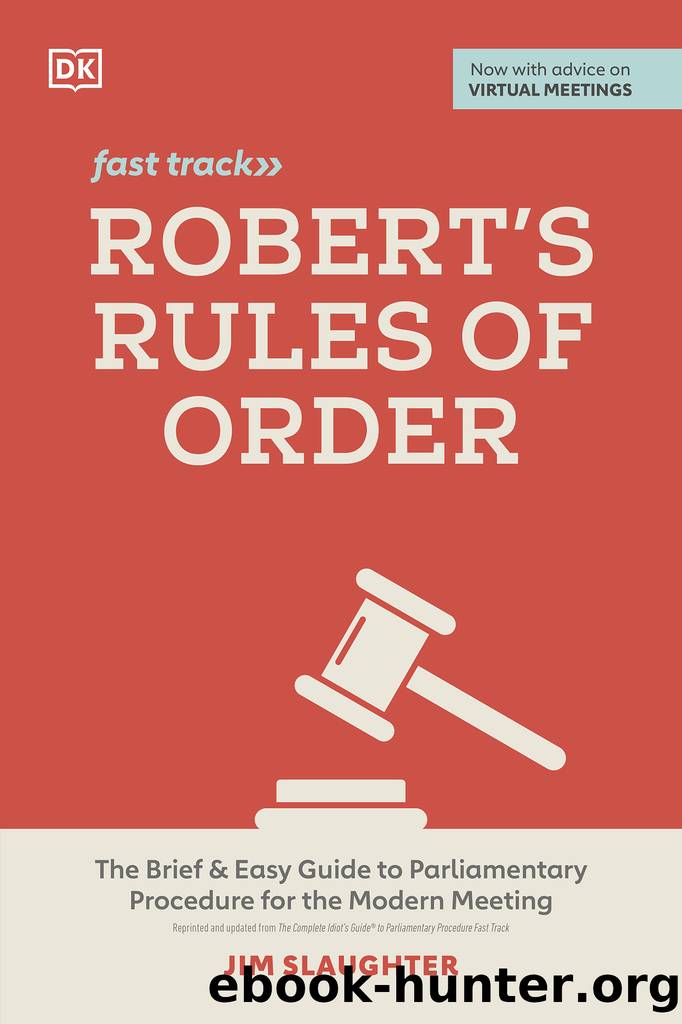Robert's Rules of Order Fast Track by Jim Slaughter

Author:Jim Slaughter
Language: eng
Format: epub
ISBN: 9780744061413
Publisher: DK Publishing
Absentee Voting
Most of Robertâs is focused on decisions made in meetings. However, the book recognizes that statutes or governing documents might occasionally allow members who arenât at a meeting to participate. Such instances can include ballots permitted outside of a meeting or voting by mail, email or fax, or by proxy voting. Again, either the bylaws or state law must expressly allow such voting. Robertâs tends to be of little help because such decision-making processes donât involve a meeting.
Voting by Mail
Voting by mail, email, or fax is generally reserved for when few members attend meetings, but a full membership vote is desired. Votes by mail are sometimes used by large national associations or large community associations. Some statutes even require certain types of votes, such as the election of directors, to be conducted by mail vote.
Before any vote by mail, detailed rules should be adopted as to the marking and returning of ballots. Very often, an inner envelope is sent to the voter with the ballot, in addition to a self-addressed, outer return envelope. That way, the vote of the member can be kept secret.
Preferential or Ranked-Choice Voting
Though beyond the scope of this book, preferential voting (or âranked votingâ or âranked-choice votingâ) describes any number of voting methods by which the second or less-preferred choices of voters can be taken into account on a single written or electronic ballot. In other words, preferential voting is an attempt to allow repeated balloting with a single ballot. In one method, each voter ranks all candidates numerically. If no candidate wins among the first-choice votes, the votes for the candidate receiving the fewest first-choice votes are redistributed among the remaining candidates. This process continues until sufficient candidates receive the necessary votes.
There are numerous methods of preferential voting. Such varying methods tend to calculate and treat secondary choices differently, which can result in different outcomes.
Improper Straw Polls
Occasionally, a member will suggest taking an informal âstraw pollâ to test opinions on an issue. Beware! Robertâs flat-out states that a straw poll âis not in order because it neither adopts nor rejects a measure and hence is meaningless and dilatory.â It will also confuse the issue because members on the âwinningâ side of the straw poll wonât understand why the results arenât binding on the assembly.
Proxies
A proxy is a power of attorney given to another to vote in the memberâs stead. In other words, if I give my proxy to Mary Smith, Mary can attend the meeting and participate on my behalf. But if Mary misses the meeting, itâs as though Iâm not at the meeting. My proxy only matters if Mary attends the meeting.
By statute, proxy voting is often permitted in for-profit and nonprofit corporations and community associations. Proxy voting is almost universally prohibited in board meetings because directors canât usually give away their responsibilities. Follow any statutory or governing document language as to proxies to the letter.
If proxies werenât complicated enough, there are five different generally recognized types of proxy:
General proxy: The holder of the proxy has discretion to do whatever they want at the meeting.
Download
This site does not store any files on its server. We only index and link to content provided by other sites. Please contact the content providers to delete copyright contents if any and email us, we'll remove relevant links or contents immediately.
Zero to IPO: Over $1 Trillion of Actionable Advice from the World's Most Successful Entrepreneurs by Frederic Kerrest(4313)
Machine Learning at Scale with H2O by Gregory Keys | David Whiting(4200)
Never by Ken Follett(3801)
Harry Potter and the Goblet Of Fire by J.K. Rowling(3776)
Ogilvy on Advertising by David Ogilvy(3520)
Shadow of Night by Deborah Harkness(3308)
The Man Who Died Twice by Richard Osman(2998)
Book of Life by Deborah Harkness(2869)
The Tipping Point by Malcolm Gladwell(2830)
Will by Will Smith(2797)
0041152001443424520 .pdf by Unknown(2787)
My Brilliant Friend by Elena Ferrante(2776)
How Proust Can Change Your Life by Alain De Botton(2746)
Purple Hibiscus by Chimamanda Ngozi Adichie(2659)
How to Pay Zero Taxes, 2018 by Jeff A. Schnepper(2604)
Hooked: A Dark, Contemporary Romance (Never After Series) by Emily McIntire(2502)
Rationality by Steven Pinker(2295)
Borders by unknow(2232)
Can't Hurt Me: Master Your Mind and Defy the Odds - Clean Edition by David Goggins(2230)
